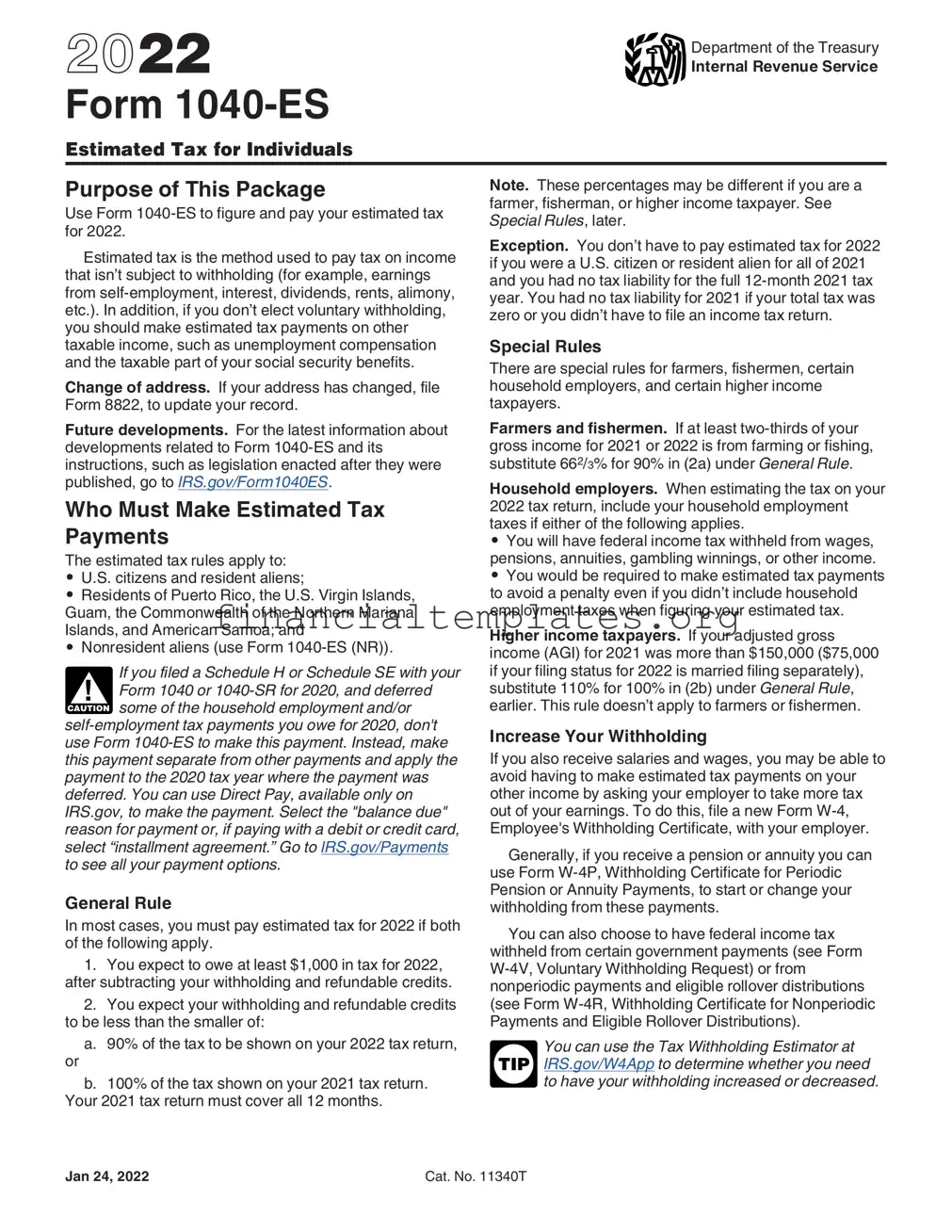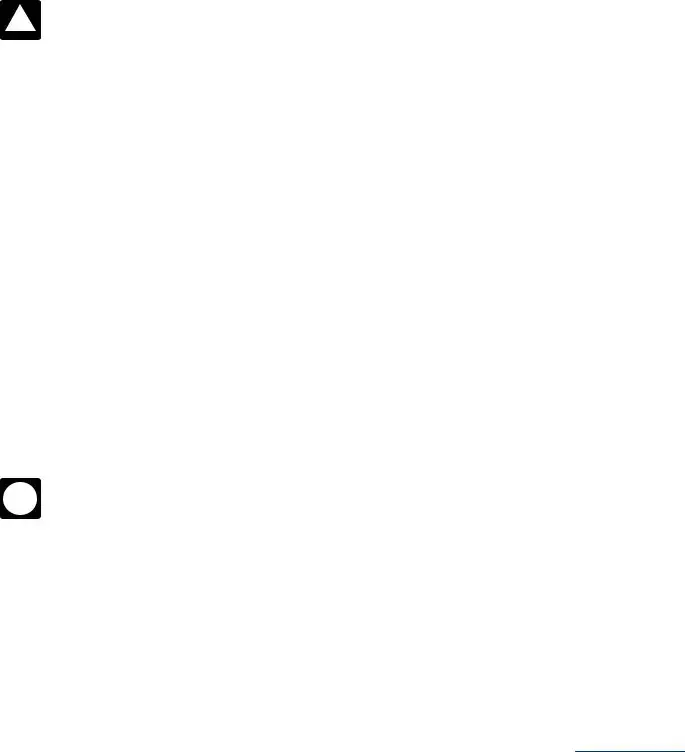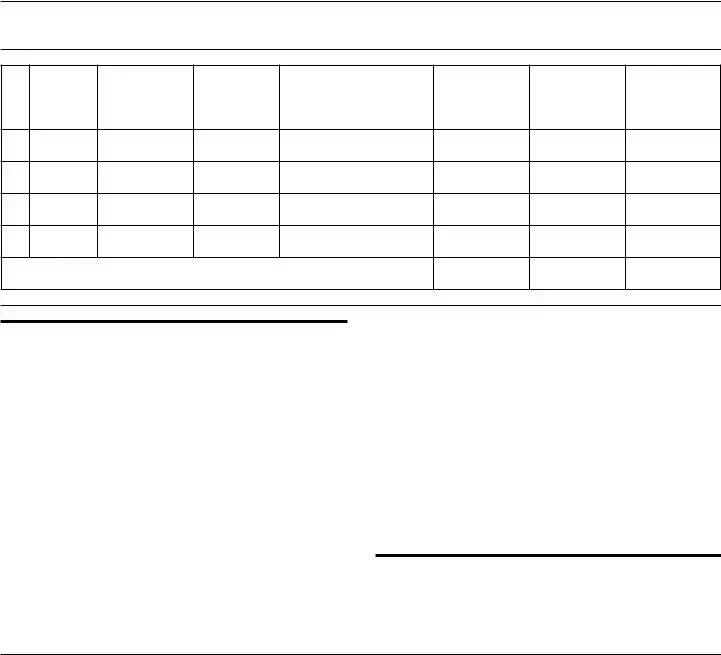|
|
|
|
|
|
|
|
|
|
|
|
Purpose of This Package |
Note. These percentages may be different if you are a |
|
Use Form 1040-ES to figure and pay your estimated tax |
farmer, fisherman, or higher income taxpayer. See |
|
Special Rules, later. |
|
for 2022. |
Exception. You don’t have to pay estimated tax for 2022 |
|
|
Estimated tax is the method used to pay tax on income |
|
|
if you were a U.S. citizen or resident alien for all of 2021 |
|
that isn’t subject to withholding (for example, earnings |
and you had no tax liability for the full 12-month 2021 tax |
|
from self-employment, interest, dividends, rents, alimony, |
year. You had no tax liability for 2021 if your total tax was |
|
etc.). In addition, if you don’t elect voluntary withholding, |
zero or you didn’t have to file an income tax return. |
|
you should make estimated tax payments on other |
Special Rules |
|
taxable income, such as unemployment compensation |
|
and the taxable part of your social security benefits. |
There are special rules for farmers, fishermen, certain |
|
Change of address. If your address has changed, file |
household employers, and certain higher income |
|
Form 8822, to update your record. |
taxpayers. |
|
Future developments. For the latest information about |
Farmers and fishermen. If at least two-thirds of your |
|
developments related to Form 1040-ES and its |
gross income for 2021 or 2022 is from farming or fishing, |
|
instructions, such as legislation enacted after they were |
substitute 662/3% for 90% in (2a) under General Rule. |
|
published, go to |
IRS.gov/Form1040ES |
. |
|
Household employers. When estimating the tax on your |
|
|
|
|
Who Must Make Estimated Tax |
taxes if either of the following applies. |
|
Payments |
2022 tax return, include your household employment |
|
• You will have federal income tax withheld from wages, |
|
The estimated tax rules apply to: |
pensions, annuities, gambling winnings, or other income. |
|
• |
U.S. citizens and resident aliens; |
• You would be required to make estimated tax payments |
|
• |
Residents of Puerto Rico, the U.S. Virgin Islands, |
to avoid a penalty even if you didn’t include household |
|
Guam, the Commonwealth of the Northern Mariana |
employment taxes when figuring your estimated tax. |
|
Islands, and American Samoa; and |
Higher income taxpayers. If your adjusted gross |
|
• |
Nonresident aliens (use Form 1040-ES (NR)). |
income (AGI) for 2021 was more than $150,000 ($75,000 |
|
|
! |
If you filed a Schedule H or Schedule SE with your |
if your filing status for 2022 is married filing separately), |
|
|
Form 1040 or 1040-SR for 2020, and deferred |
substitute 110% for 100% in (2b) under General Rule, |
|
CAUTION some of the household employment and/or |
earlier. This rule doesn’t apply to farmers or fishermen. |
|
self-employment tax payments you owe for 2020, don't |
Increase Your Withholding |
|
use Form 1040-ES to make this payment. Instead, make |
|
this payment separate from other payments and apply the |
If you also receive salaries and wages, you may be able to |
|
payment to the 2020 tax year where the payment was |
avoid having to make estimated tax payments on your |
|
deferred. You can use Direct Pay, available only on |
other income by asking your employer to take more tax |
|
IRS.gov, to make the payment. Select the "balance due" |
out of your earnings. To do this, file a new Form W-4, |
|
reason for payment or, if paying with a debit or credit card, |
Employee's Withholding Certificate, with your employer. |
|
select “installment agreement.” Go to IRS.gov/Payments |
Generally, if you receive a pension or annuity you can |
|
to see all your payment options. |
|
|
|
use Form W-4P, Withholding Certificate for Periodic |
|
General Rule |
Pension or Annuity Payments, to start or change your |
|
withholding from these payments. |
|
In most cases, you must pay estimated tax for 2022 if both |
You can also choose to have federal income tax |
|
of the following apply. |
|
withheld from certain government payments (see Form |
|
|
1. You expect to owe at least $1,000 in tax for 2022, |
|
|
W-4V, Voluntary Withholding Request) or from |
|
after subtracting your withholding and refundable credits. |
nonperiodic payments and eligible rollover distributions |
|
|
2. You expect your withholding and refundable credits |
(see Form W-4R, Withholding Certificate for Nonperiodic |
|
to be less than the smaller of: |
Payments and Eligible Rollover Distributions). |
|
or |
a. |
90% of the tax to be shown on your 2022 tax return, |
|
You can use the Tax Withholding Estimator at |
|
b. 100% of the tax shown on your 2021 tax return. |
TIP |
IRS.gov/W4App to determine whether you need |
|
|
|
|
|
|
|
|
to have your withholding increased or decreased. |
|
Your 2021 tax return must cover all 12 months. |
|
|
|










